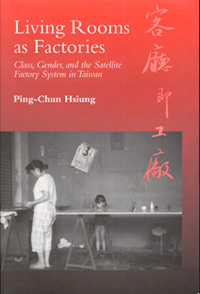Research
Research › Living Rooms as Factories

Living Rooms as Factories: Class,
Gender, and the Satellite Factory
System in Taiwan, 1996.
Philadephia: Temple University Press
Living Rooms as Factories: Class, Gender, and the Satellite Factory System in Taiwan
In the 70s and 80s, as Taiwan was incorporated into global market, small-scale subcontracting factories of thirty employees or less made items for export, like the wooden jewelry boxes that I made when I worked in six such factories. These factories were found in rice fields and urban areas, front yards and living rooms, mostly employing married women in line with the government slogan that promotes work in the home--"Living Rooms as Factories."
This study examines the experiences of the married women who work in this satellite system of factories, and how their work and family lives have contributed to Taiwan¡s 9.1% GNP growth over the last three decades, the "economic miracle." This vivid portrayal of the dual lives of these women as wives, mothers, daughters and as manufacturing workers also provides sophisticated analyses of the links between class and gender stratification, family dynamics, state policy, and global restructuring within the process of industrialization.
I use ethnographic data to illustrate how, in this system of intersecting capitalist logic and patriarchal practices, some Taiwanese women experience upward mobility by marrying into the owner¡s family, while others remain home and wage workers. Although women in both groups acknowledge gender inequality, this commonality does not bridge divergent class affiliations. Along with a detailed account of the oppressive labor practices, this book reveals how workers employ clandestine tactics to defy the owners¡ claims on their labor.